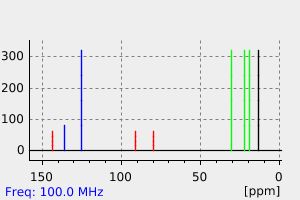2,6-bis(hex-1-ynyl)pyridine | 500228-78-4
中文名称
——
中文别名
——
英文名称
2,6-bis(hex-1-ynyl)pyridine
英文别名
2,6-di(hex-1-ynyl)pyridine;2,6-di-1-hexynylpyridine;Fotcfqzwhavric-uhfffaoysa-
CAS
500228-78-4
化学式
C17H21N
mdl
——
分子量
239.36
InChiKey
FOTCFQZWHAVRIC-UHFFFAOYSA-N
BEILSTEIN
——
EINECS
——
-
物化性质
-
计算性质
-
ADMET
-
安全信息
-
SDS
-
制备方法与用途
-
上下游信息
-
文献信息
-
表征谱图
-
同类化合物
-
相关功能分类
-
相关结构分类
物化性质
-
沸点:383.0±27.0 °C(Predicted)
-
密度:0.97±0.1 g/cm3(Predicted)
计算性质
-
辛醇/水分配系数(LogP):5.5
-
重原子数:18
-
可旋转键数:6
-
环数:1.0
-
sp3杂化的碳原子比例:0.47
-
拓扑面积:12.9
-
氢给体数:0
-
氢受体数:1
反应信息
-
作为反应物:描述:2,6-bis(hex-1-ynyl)pyridine 在 palladium 10% on activated carbon 、 氢气 作用下, 以 四氢呋喃 、 甲醇 、 二氯甲烷 为溶剂, 生成 2,6-dihexyl-1-methylpyridinium trifluoromethanesulfonate参考文献:名称:Structure–Affinity Relationships (SARs) and Structure–Kinetics Relationships (SKRs) of Kv11.1 Blockers摘要:K(v)11.1 (hERG) blockers with comparable potencies but different binding kinetics might display divergent proarrhythmic risks. In the present study, we explored structure-kinetics relationships in four series of K(v)11.1 blockers next to their structure affinity relationships. We learned that despite dramatic differences in affinities and association rates, there were hardly any variations in the dissociation rate constants of these molecules with residence times (RTs) of a few minutes only. Hence, we synthesized 16 novel molecules, in particular in the pyridinium class of compounds, to further address this peculiar phenomenon. We found molecules with very short RTs (e.g., 0.34 min for 37) and much longer RTs (e.g., 105 min for 38). This enabled us to construct a k(on)-k(off)-K-D kinetic map for all compounds and subsequently divide the map into four provisional quadrants, providing a possible framework for a further and more precise categorization of K(v)11.1 blockers. Additionally, two representative compounds (21 and 38) were tested in patch clamp assays, and their RTs were linked to their functional IC50 values. Our findings strongly suggest the importance of the simultaneous study of ligand affinities and kinetic parameters, which may help to explain and predict K(v)11.1-mediated cardiotoxicity.DOI:10.1021/acs.jmedchem.5b00518
-
作为产物:描述:2,6-二溴吡啶 、 1-己炔 在 bis-triphenylphosphine-palladium(II) chloride 、 copper(l) iodide 、 三乙胺 作用下, 以 四氢呋喃 为溶剂, 反应 12.0h, 生成 2,6-bis(hex-1-ynyl)pyridine参考文献:名称:走向可以沿着轨道定向行走的金属配合物:用钯 (II) 脚控制分子双足动物的步进摘要:我们报告了双金属分子双足动物在三足轨道上的设计、合成和操作。“助行器”具有钯 (II) 复合“脚”,可以通过可逆质子化选择性地在轨道上的 4-二甲氨基吡啶和吡啶配体位点之间移动,而助行器通过动力学惰性的铂始终保持附着在轨道上( II) 复足。三个配体结合位点的取代模式,连同金属-配体配位键的动力学稳定性,为两个位置异构体提供了高度的亚稳定性,这意味着改变轨道的化学状态不会自动引发步入没有额外的刺激(在配位溶剂存在下加热)。DOI:10.1021/ja4123973
文献信息
-
Rhodium-Catalyzed Addition of Arylboronic Acids to Alkynyl Aza-Heteroaromatic Compounds in Water作者:Mark Lautens、Masahiro YoshidaDOI:10.1021/jo0205255日期:2003.2.1Alkynyl heteroaromatic compounds reacted with arylboronic acids to give addition products in the presence of a rhodium catalyst. The best results were obtained when a novel pyridine-substituted water-soluble phosphine ligand was used. The reactions proceed to give trisubstituted alkenes from various arylboronic acids and alkynyl heteroaromatic compounds with high regioselectivity. Only alkynes with
-
Synthesis, Characterization, and Fluorescence Behavior of Twisted and Planar B<sub>2</sub>N<sub>2</sub>-Quaterphenyl Analogues作者:Cory A. Jaska、Warren E. Piers、Robert McDonald、Masood ParvezDOI:10.1021/jo0706574日期:2007.7.1quaterphenyl analogues containing BN ring linkages has been synthesized using primarily difunctional Lewis acidic diborabiphenyl moieties as molecular cores. Crystal structure analyses indicated the presence of large twist angles between adjacent aromatic rings in 1 and 3, which were also observed to possess nonfluorescent behavior due to a lack of molecular rigidity and insufficient BN character in一系列含有BN环键的平面和扭曲的杂芳族四元苯基类似物已被合成,主要使用双官能的Lewis酸性Diborabiphenyl部分作为分子核心。晶体结构分析表明,在1和3中相邻的芳环之间存在较大的扭曲角,并且由于缺乏分子刚度和在激发态下的B N特性不足,还观察到它们具有非荧光特性。与此相反,在相邻的环(经由乙炔环异构安装)之间的一个或两个桥接亚乙基的引入被发现,得到平坦的菲或芘的部分,这导致弱荧光行为(Φ ˚F = 0.02-0.16)的Ñ-Bu且Ph衍生物5 - 12。发射颜色的范围从绿色(λem = 521 nm)到红色(λem = 630 nm),主要取决于构象(2,2'- vs 4,4'-),发色团共轭的程度(菲与vs) ),以及存在的环外取代基的类型(n -Bu对Ph)。在某些情况下,观察到两个菲或pyr部分之间的通信,其特征在于相对于单体菲或pyr物种的红移改变了发射带。2,2'-异
-
10a-Aza-10b-borapyrenes: Heterocyclic Analogues of Pyrene with Internalized BN Moieties作者:Michael J. D. Bosdet、Warren E. Piers、Ted S. Sorensen、Masood ParvezDOI:10.1002/anie.200700591日期:2007.6.25
表征谱图
-
氢谱1HNMR
-
质谱MS
-
碳谱13CNMR
-
红外IR
-
拉曼Raman
-
峰位数据
-
峰位匹配
-
表征信息
同类化合物
(S)-氨氯地平-d4
(R,S)-可替宁N-氧化物-甲基-d3
(R)-(+)-2,2'',6,6''-四甲氧基-4,4''-双(二苯基膦基)-3,3''-联吡啶(1,5-环辛二烯)铑(I)四氟硼酸盐
(R)-N'-亚硝基尼古丁
(R)-DRF053二盐酸盐
(5E)-5-[(2,5-二甲基-1-吡啶-3-基-吡咯-3-基)亚甲基]-2-亚磺酰基-1,3-噻唑烷-4-酮
(5-溴-3-吡啶基)[4-(1-吡咯烷基)-1-哌啶基]甲酮
(5-氨基-6-氰基-7-甲基[1,2]噻唑并[4,5-b]吡啶-3-甲酰胺)
(2S,2'S)-(-)-[N,N'-双(2-吡啶基甲基]-2,2'-联吡咯烷双(乙腈)铁(II)六氟锑酸盐
(2S)-2-[[[9-丙-2-基-6-[(4-吡啶-2-基苯基)甲基氨基]嘌呤-2-基]氨基]丁-1-醇
(2R,2''R)-(+)-[N,N''-双(2-吡啶基甲基)]-2,2''-联吡咯烷四盐酸盐
(1'R,2'S)-尼古丁1,1'-Di-N-氧化物
黄色素-37
麦斯明-D4
麦司明
麝香吡啶
鲁非罗尼
鲁卡他胺
高氯酸N-甲基甲基吡啶正离子
高氯酸,吡啶
高奎宁酸
马来酸溴苯那敏
马来酸氯苯那敏-D6
马来酸左氨氯地平
顺式-双(异硫氰基)(2,2'-联吡啶基-4,4'-二羧基)(4,4'-二-壬基-2'-联吡啶基)钌(II)
顺式-二氯二(4-氯吡啶)铂
顺式-二(2,2'-联吡啶)二氯铬氯化物
顺式-1-(4-甲氧基苄基)-3-羟基-5-(3-吡啶)-2-吡咯烷酮
顺-双(2,2-二吡啶)二氯化钌(II) 水合物
顺-双(2,2'-二吡啶基)二氯化钌(II)二水合物
顺-二氯二(吡啶)铂(II)
顺-二(2,2'-联吡啶)二氯化钌(II)二水合物
韦德伊斯试剂
非那吡啶
非洛地平杂质C
非洛地平
非戈替尼
非布索坦杂质66
非尼拉朵
非尼拉敏
雷索替丁
阿雷地平
阿瑞洛莫
阿扎那韦中间体
阿培利司N-6
阿伐曲波帕杂质40
间硝苯地平
间-硝苯地平
镉,二碘四(4-甲基吡啶)-
锌,二溴二[4-吡啶羧硫代酸(2-吡啶基亚甲基)酰肼]-







